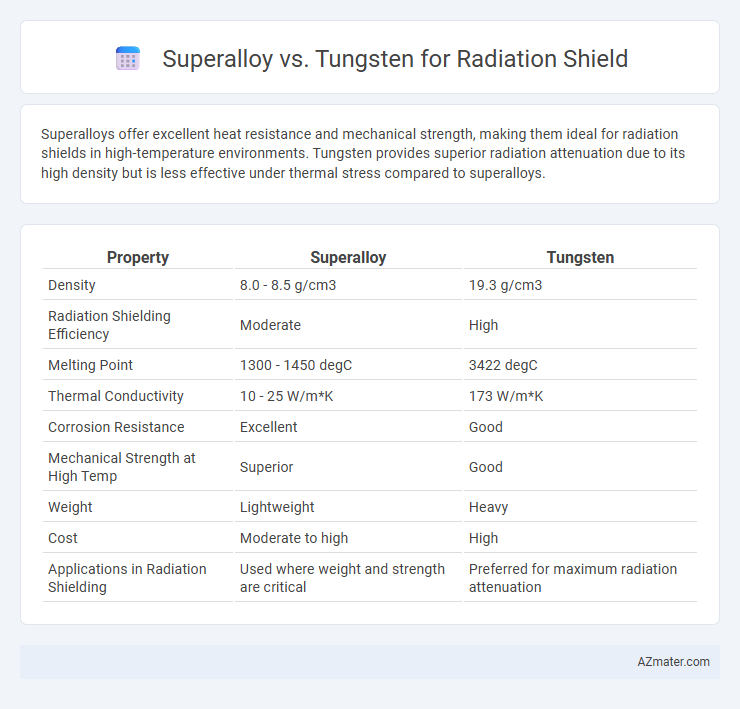Superalloys offer excellent heat resistance and mechanical strength, making them ideal for radiation shields in high-temperature environments. Tungsten provides superior radiation attenuation due to its high density but is less effective under thermal stress compared to superalloys.
Table of Comparison
| Property | Superalloy | Tungsten |
|---|---|---|
| Density | 8.0 - 8.5 g/cm3 | 19.3 g/cm3 |
| Radiation Shielding Efficiency | Moderate | High |
| Melting Point | 1300 - 1450 degC | 3422 degC |
| Thermal Conductivity | 10 - 25 W/m*K | 173 W/m*K |
| Corrosion Resistance | Excellent | Good |
| Mechanical Strength at High Temp | Superior | Good |
| Weight | Lightweight | Heavy |
| Cost | Moderate to high | High |
| Applications in Radiation Shielding | Used where weight and strength are critical | Preferred for maximum radiation attenuation |
Introduction to Radiation Shielding Materials
Superalloys and tungsten are prominent materials in radiation shielding due to their high density and atomic number, which enhance their ability to attenuate ionizing radiation. Superalloys, composed mainly of nickel, cobalt, or iron, provide excellent mechanical strength and corrosion resistance under high-temperature conditions, making them suitable for environments exposed to intense radiation and heat. Tungsten, characterized by its exceptional density (19.3 g/cm3) and atomic number (74), offers superior gamma-ray and X-ray attenuation, making it ideal for compact and efficient radiation shields in medical, industrial, and aerospace applications.
Overview of Superalloys
Superalloys are advanced high-performance metal alloys primarily composed of nickel, cobalt, or iron, designed to maintain strength and resist radiation damage at elevated temperatures. Their exceptional corrosion resistance, thermal stability, and mechanical properties make them ideal for radiation shielding in harsh environments such as nuclear reactors and aerospace applications. Compared to tungsten, superalloys offer a versatile balance of density and durability, enabling efficient attenuation of radiation while withstanding extreme operating conditions.
Properties of Tungsten
Tungsten exhibits exceptional density of 19.3 g/cm3 and a high atomic number (74), making it highly effective for radiation shielding by attenuating gamma rays and X-rays. Its melting point of 3422degC ensures structural integrity under extreme thermal conditions, outperforming many superalloys in heat resistance. Despite being less ductile than superalloys, tungsten's superior hardness and corrosion resistance contribute to its durability in harsh radiation environments.
Radiation Attenuation Capabilities
Superalloys exhibit superior radiation attenuation capabilities compared to tungsten due to their complex composition of nickel, chromium, and cobalt, which enhances neutron moderation and gamma-ray absorption effectively. Tungsten offers high-density properties ideal for shielding against gamma radiation but is less effective in neutron attenuation compared to superalloys. The combination of high atomic number elements and alloying strategies in superalloys provides optimized protection in mixed radiation fields, making them preferable in advanced nuclear and aerospace applications.
Density and Material Composition
Superalloys, primarily composed of nickel, cobalt, or iron with significant amounts of chromium, aluminum, and titanium, offer moderate density typically ranging between 8 to 9 g/cm3, providing effective structural integrity and thermal resistance in radiation shielding applications. Tungsten, with an exceptionally high density of approximately 19.3 g/cm3 and a pure elemental composition, delivers superior radiation attenuation, especially for gamma rays and X-rays, due to its heavy atomic mass and high atomic number. The material composition and density differences make tungsten ideal for compact, high-efficiency shields, while superalloys excel where combined mechanical strength and moderate radiation protection are required.
Mechanical Strength and Durability
Superalloys, known for their exceptional mechanical strength at high temperatures, outperform tungsten in radiation shield applications requiring durability under extreme thermal and mechanical stress. Tungsten offers superior density and radiation attenuation but is more prone to brittleness and mechanical failure under cyclic loading conditions. The combination of superalloy's ductility and strength with tungsten's radiation shielding capabilities often leads to hybrid solutions optimized for both durability and protection.
Corrosion and Oxidation Resistance
Superalloys exhibit superior corrosion and oxidation resistance compared to tungsten, making them ideal for radiation shields exposed to high-temperature and reactive environments. Tungsten, while having exceptional density for radiation attenuation, is prone to oxidation at elevated temperatures, which compromises its structural integrity. The corrosion resistance offered by superalloys extends service life and reduces maintenance in radiation shielding applications.
Fabrication and Machinability
Superalloys exhibit superior fabrication flexibility and machinability compared to tungsten, enabling complex geometries for radiation shielding applications. Tungsten's high density offers excellent radiation attenuation but poses challenges during machining due to its brittleness and hardness, often requiring specialized tools and processes. The relative ease of machining superalloys reduces manufacturing costs and lead times, making them favorable for custom or intricate radiation shield designs.
Cost and Availability Comparison
Superalloys, composed primarily of nickel, cobalt, and iron, typically present higher costs due to complex manufacturing and raw material expenses but offer superior high-temperature strength and corrosion resistance, making them valuable in radiation shield applications where durability is critical. Tungsten excels in radiation shielding effectiveness because of its high density but is often more cost-effective and widely available than superalloys, benefiting from established mining and refining industries. Availability of tungsten is generally more stable globally, whereas superalloy supply can be constrained by the scarcity of strategic alloying elements and production complexities, influencing project budgets and timelines.
Best Applications for Superalloy vs Tungsten
Superalloys excel in high-temperature and high-stress environments due to their superior mechanical strength and corrosion resistance, making them ideal for aerospace components and nuclear reactor shielding where thermal stability and radiation resistance are critical. Tungsten, with its exceptional density and atomic number, provides superior gamma radiation attenuation, making it the preferred material for medical radiation shields and industrial radiography equipment. Applications requiring combined mechanical durability and moderate radiation protection benefit from superalloys, while those demanding maximum radiation blockage prioritize tungsten.

Infographic: Superalloy vs Tungsten for Radiation Shield
 azmater.com
azmater.com